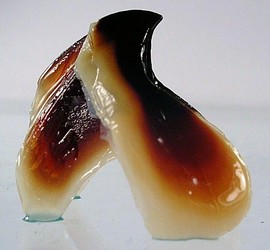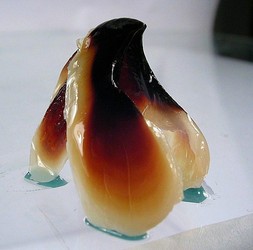Onykia aequatorialis
K.S.R. BolstadIntroduction
This specimen was found floating dead at the surface and described by Thiele (1920) as a new species, distinct from the two other then-known species of "Moroteuthis" (M. ingens and M. robusta) based on its size, the rostrum of the gladius, and several other bodily proportions.
Diagnosis
An Onykia ...
- found in the equatorial Atlantic and Gulf of Mexico.
- with rhomboidal fins (ie fins not drawn-out posteriorly).
- with warts on the skin.
- with rostrum of gladius <15% GL and oval in cross-section.
Characteristics
- Tentacles
- Unknown - lost in both known specimens (spent females).
- Arms
- 48-60% ML, with Arms IV distinctly longest.
- Head
- Lower beak rounded, length and depth approximately equal.
- Mantle
- Epidermis with soft, irregular warts.
- Epidermis with soft, irregular warts.
- Fins
- Rhomboidal shape, not drawn out into a tail.
- Length ~55% of ML.
- Width ~70% of ML.
- Gladius
- Maximum width of vanes ca. 13% of gladius length (to tip of conus).
- Extant portion of rostrum ~12% of the ML, oval in cross-section.



Figure. Lower beak of Onykia aequatorialis Holotype. Left - left profile view. Right - left oblique view. Photographs by K. Bolstad.
Comments
Due to previously uncertain deposition of the Holotype, this species has been considered a nomen dubium (Tsuchiya & Okutani 1991). However, examination of the type has revealed that it is distinct from other known Onykia species. The beak is readily distinguishable from both O. robsoni and O. ingens. The shorter rostrum of the gladius and the rhombic (not drawn-out) fins also separate O. aequatorialis from O. robsoni, while oval cross-section of the rostrum of the gladius and the distinctly longest Arms IV separate it from O. ingens.
Both known specimens of this species are spent females.
References
Thiele, J. 1920. Die Cephalopoden der Deutschen Südpolar Expedition. Deutsche Südpolar Expedition, Zoologie, 16: 433–465, Pl. 53, 54.
Tsuchiya, K.; Okutani, T. 1991. Growth Stages of Moroteuthis robusta (Verrill, 1881) with the Re-evaluation of the Genus. Bulletin of Marine Science 49(1/2): 137–147.
Title Illustrations

| Scientific Name | Moroteuthis aequatorialis |
|---|---|
| Location | Equatorial Atlantic, 0°16′ N, 18°07′ W |
| Specimen Condition | Preserved |
| Sex | Female |
| Life Cycle Stage | Spent |
| View | Dorsal |
| Size | 380 mm ML (preserved; 400 mm fresh according to description) |
| Collection | ZMB Holotype Moll.-110000 |
| Type | Holotype |
| Copyright |
© 2007 K.S.R. Bolstad

|
About This Page
K.S.R. Bolstad

Auckland University of Technology
Correspondence regarding this page should be directed to K.S.R. Bolstad at
Page copyright © 2011 K.S.R. Bolstad
 Page: Tree of Life
Onykia aequatorialis .
Authored by
K.S.R. Bolstad.
The TEXT of this page is licensed under the
Creative Commons Attribution License - Version 3.0. Note that images and other media
featured on this page are each governed by their own license, and they may or may not be available
for reuse. Click on an image or a media link to access the media data window, which provides the
relevant licensing information. For the general terms and conditions of ToL material reuse and
redistribution, please see the Tree of Life Copyright
Policies.
Page: Tree of Life
Onykia aequatorialis .
Authored by
K.S.R. Bolstad.
The TEXT of this page is licensed under the
Creative Commons Attribution License - Version 3.0. Note that images and other media
featured on this page are each governed by their own license, and they may or may not be available
for reuse. Click on an image or a media link to access the media data window, which provides the
relevant licensing information. For the general terms and conditions of ToL material reuse and
redistribution, please see the Tree of Life Copyright
Policies.
- First online 09 July 2007
- Content changed 09 July 2007
Citing this page:
Bolstad, K.S.R. 2007. Onykia aequatorialis . Version 09 July 2007 (under construction). http://tolweb.org/Onykia_aequatorialis/108190/2007.07.09 in The Tree of Life Web Project, http://tolweb.org/








 Go to quick links
Go to quick search
Go to navigation for this section of the ToL site
Go to detailed links for the ToL site
Go to quick links
Go to quick search
Go to navigation for this section of the ToL site
Go to detailed links for the ToL site